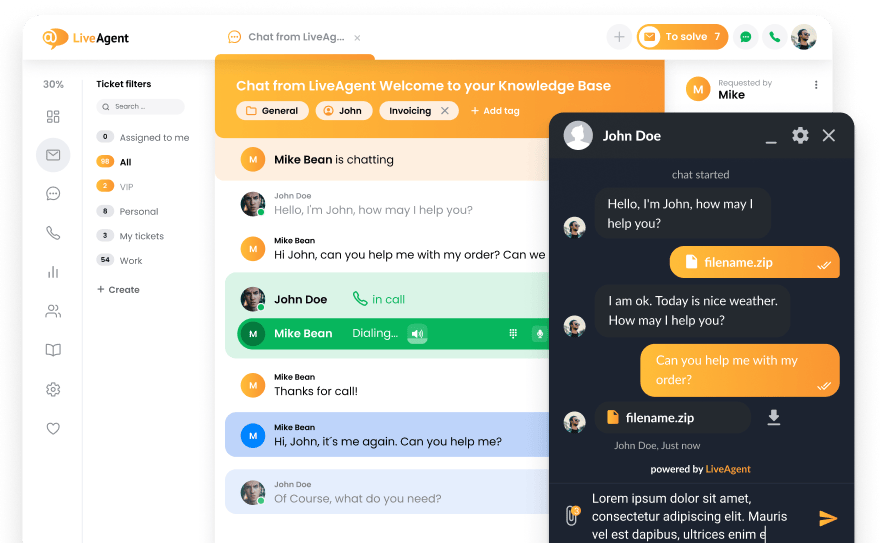Definition of escalation
In terms of customer service, escalation is a situation when a first-line support agent is unable to resolve a customer’s issue, so needs to be passed along to another team member. These issues are usually escalated to someone with the appropriate expertise (functional escalation) or a higher-level support team member in a position of more authority (hierarchical escalation).
Escalation isn’t always a negative thing in customer service. It may happen when a new support agent joins the team and doesn’t yet have the required knowledge to efficiently handle customer issues. It might also occur when authorization must be granted to resolve the issue (e.g., from a finance department). Whatever the case, having an efficient escalation management process in place helps reduce the number of frustrated customers, improve customer satisfaction and the overall customer service experience.
What are the escalation factors?
- Insufficient agent knowledge: One of the most obvious reasons for the escalation in customer service is the lack of the right expertise or insufficient agent training.
- Miscommunication: Escalation can also be caused by miscommunication between an agent and a customer.
- Service Level Agreement (SLA) violation: If a customer reaches out to your support team but doesn’t get a response within the timeframe set out in your Service Level Agreement (SLA), the issue then gets escalated to speed up the resolution process.

Conflict escalation
Conflict occurs and escalates when the parties can’t agree on a certain course of action. In customer service, conflicts usually arise between customers and service agents when customers encounter problems with a product or service that agents can’t resolve immediately. Conflicts can also happen within the customer support team itself, between agents and managers, or between customer support and other departments.
What are the signs of escalation?
A customer may simply demand to get transferred to a manager if an agent can’t satisfy their request and resolve the issue instantly. However, managing escalations means having to deal with frustrated customers who could potentially become aggressive when interacting with service reps. It makes sense to escalate an issue when a customer starts to argue, shout, lose control of emotions, use offensive language, or threaten to spread negative word-of-mouth/ leave a bad review unless their needs are met.
Customer service escalation handling
Design a comprehensive escalation matrix
Have a well-defined escalation path (detailed in the SLAs) for the most common types of issues. When a customer’s issue requires a higher level of assistance, agents must have a clear understanding of when an issue should be escalated, how to initiate an escalation process and find the right person who will be responsible for handling the case. In addition, agents must know how escalation should be positioned to the customer.
Provide appropriate customer support training
Make sure each member of your support team goes through the relevant training, knows how to manage even the toughest customer complaints, and has the right skill set. Providing appropriate customer support training includes teaching de-escalation techniques for customer service to manage difficult situations effectively.
Some of the most critical customer service soft skills to pay attention to are active listening, empathy, negotiation, stress management, problem-solving, and conflict resolution skills.

How can we prevent escalation?
Consistently document key information whenever escalations happen and share that knowledge across the entire support team. E.g., Tier 1 agent is unable to resolve an issue and escalates it to a higher-tier agent. Once that higher-tier agent resolves the issue, they document the solution in the company’s internal knowledge base. When a similar issue occurs, a Tier 1 agent can refer to a knowledge base and resolve it from the get-go rather than having to escalate it.
Escalation rate
Escalation rate is the percentage of support requests that weren’t resolved at the first contact and have been escalated beyond first-line support. Escalation rate often pairs with other critical customer service metrics like first contact resolution rate (FCR), first response time (FRT), and overall resolution time that help measure the effectiveness of a company’s customer support process. It is a particularly important metric to track for measuring the effectiveness of your first-line support. Especially when it comes to large support teams where agents have varying specializations.
How to calculate escalation rate
Escalation rate = No. of escalated support tickets/ Total No. of support tickets
To calculate your escalation rate, you need to divide the number of escalated support tickets by the total number of support tickets over a certain time period. The escalation rate can be tracked on a daily, weekly, or monthly basis. A high escalation rate would typically indicate potential issues in your customer support processes, or that your team needs additional training.
Reduce your escalation rate
LiveAgent is the right help desk software that will help you win your customers over. Want to try it for yourself?
Frequently Asked Questions
What is email escalation?
Email escalation is the process of forwarding an email to a higher level of authority or management when the initial recipient is unable to address the issue or provide a satisfactory resolution. This can help ensure that important matters are addressed in an appropriate manner.
What is the definition of escalation?
In customer service, escalation happens when a first-tier support agent is unable to resolve a customer’s issue during the first interaction and thus the issue needs to be passed on to another agent. That might either be someone with the required expertise (functional escalation) or someone who is authorized to handle this type of issue (hierarchical escalation).
How do you handle social media escalations?
Handling social media escalations requires active monitoring of your social media channels for any mentions or discussions related to the company. By staying informed and proactive, companies can respond promptly to concerns and demonstrate their commitment to addressing customer feedback. Creating a clear escalation process ensures that issues are addressed promptly and effectively. This can involve defining roles and responsibilities for handling social media escalations, establishing communication protocols, and providing training for agents who may be involved in addressing these issues.
How do you handle customer service escalations?
When it comes to customer service escalation handling, there are two important factors to pay attention to for ensuring a positive outcome. First, there should be a clearly defined escalation path guiding agents on when and how should be issues escalated. Second, agents should be properly trained and possess the right soft skills that are needed to efficiently handle conflicts.
What is a conflict escalation?
Conflict escalation occurs whenever the involved parties cannot agree on a course of action. In the customer service realm, conflicts commonly arise between customers and agents and escalate when instant resolution isn’t possible. Conflicts can also happen within the customer service team or between departments.
What can be a sign of escalation?
When interacting with customers, it sometimes makes sense to instantly escalate an issue to a manager or someone with more decision-making power before it becomes a bigger problem. These are mostly situations when a customer demonstrates aggressive behavior, violence, uses offensive language, and threats.
How can we prevent escalation?
Documenting critical information in the company’s internal knowledge base when escalations occur is the key to minimizing future incidents. Whenever first-line support agents come across similar cases, they can refer to the knowledge base and resolve issues instantly with no need to escalate them further to higher-tier agents.
What is an escalation rate?
An escalation rate shows the percentage of support requests that have been escalated beyond first-line support. It is calculated by dividing the number of escalated tickets from the first tier by the total number of support tickets. Paired with FCR and other metrics, escalation rate is used to measure the effectiveness of a company’s first-line support.
What are the escalation factors?
Escalations in the customer service environment can be caused by several reasons like poor agent knowledge or inadequate training, miscommunication, as well as missed Service Level Agreements (SLAs).
After understanding the escalation process, you might want to explore more about escalation management. This section covers the various types of escalation management and how they benefit customer service. Additionally, learning about the role of an escalation manager can be crucial. Discover what an escalation manager does and why their role is vital in resolving customer issues effectively.
Provide excellent customer service.
Discover unparalleled customer support with LiveAgent's all-in-one software. Benefit from 24/7 service, a free trial without a credit card, and seamless integration across 130+ ticketing features. Enhance your business with fast setup, AI assistance, live chat, and more. Choose LiveAgent for exceptional service and satisfied customers.

 Български
Български  Čeština
Čeština  Dansk
Dansk  Deutsch
Deutsch  Eesti
Eesti  Español
Español  Français
Français  Ελληνικα
Ελληνικα  Hrvatski
Hrvatski  Italiano
Italiano  Latviešu
Latviešu  Lietuviškai
Lietuviškai  Magyar
Magyar  Nederlands
Nederlands  Norsk bokmål
Norsk bokmål  Polski
Polski  Română
Română  Русский
Русский  Slovenčina
Slovenčina  Slovenščina
Slovenščina  简体中文
简体中文  Tagalog
Tagalog  Tiếng Việt
Tiếng Việt  العربية
العربية  Português
Português 







